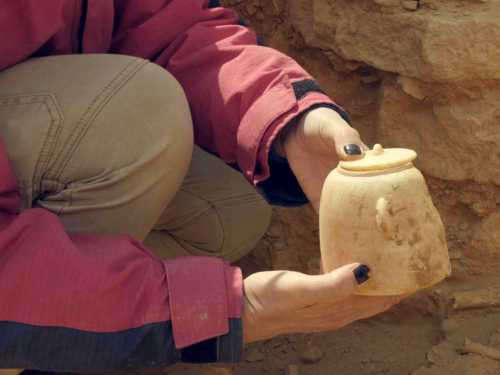
Evidence of Trade Caravans from 2,500 Years Ago Uncovered in the Negev
An excavation in the holy land has revealed tombs of trade caravans from Yemen, Phoenicia and Egypt that travelled through here. Many objects were placed next to the deceased, including arrowheads from Yemen.
*The researchers: the caravans traded frankincense and myrrh and possibly women as well*
The discovery will be presented as part of a lecture series entitled: “Archaeological Mysteries” in the in the Jay and Jeanie Schottenstein National Campus.
What is a 2,500 year-old tomb compound with dozens of burials doing in an unknown site in the Negev Highlands? Researchers who discovered the unique site near Tlalim Junction believe that it tells the story of trade caravans from Arabia who passed through here, and even caravans from as far away as Yemen.
“The unique concentration of flint artifacts uncovered in the site are unparalleled in the holy land and the only source that we know of is Yemen and Oman”, says Dr. Jacob Vardi, An expert on flint tools. “We found traces of red ochre on some of the artifacts – a substance that was used in ancient cultures to symbolize blood and for other decorative purposes. The presence of ochre on these arrowheads may indicate their religious or cultic significance as having special value.”
Dr. Martin David Pasternak, Excavation director , and senior researcher Dr. Tali Erickson-Gini say, “the discovery is unique and it points to wide-reaching cultural interchange between southern and northern Arabia, Phoenicia, Egypt and southern Europe. A rich variety of artifacts were revealed in the two tombs that we uncovered, which are dated to between the 7th and 5th centuries BCE: copper and silver jewelry, alabaster artifacts for preparing incense, hundreds of beads made from different kinds
of colorful stones, rare kinds of shells, an amulet in the shape of the Egyptian god Bes, alabaster vessels that were used to transport incense resins from southern Arabia, and more and more. The great variety of finds are evidence that this previously unknown site was a place of burial for trade caravans during that period and burial and cultic practices took place here.”
The dozens of burials in the site raises two possibilities: one, that the place was used over generations for burial by trade caravans who passed by the spot, and the other – that the tombs were built for a mass burial of individuals from a caravan that came under attack.
“The tombs are not found near any sites, settlements or fortresses that could explain their presence so that they are thought to be a mystery. However, it should be noted that they are situated at a central junction of roads leading through the Negev Highlands to the Arava” say the researchers. “It appears that the remains are related to the traders from southern Arabia who were known for their long-distance journeys and who traded, among other things, incense such frankincense and myrrh. Naturally, these journeys would have taken months under difficult circumstances such as climate, the danger of raiders and other challenges.”
“This is one of the most interesting sites that we have encountered,” add Dr. Pasternak and Dr. Erickson-Gini. “The structures and the variety of finds evince our understanding that the Negev was more than just the passage of international travel – it was a lively meeting place of merchants and cultures.”
“In light of the presence of special artifacts, we assume that many of the deceased were women, and it is possible that the trade caravans conducted human trafficking; texts of traders from Yemen in the second half of the first millennium BCE (called the Minaeans) describe purchasing women, among them those from Gaza, Egypt, Greece, Moab, and Edom. An inscription discovered in Yemen lists 30 women purchased in the city of Gaza. Other evidence of the presence of women includes an amulet of the Egyptian god Bes. This god was responsible for protecting women and children from harm.
According to Eli Escusido, Director of the IAA, “The discovery emphasizes the central role of the Negev in antiquity as an international crossroad and as a gateway for trade and a meeting place of cultures. The discovery is unique and it enables us to touch small but important historical moments of the people who traversed the desert through this place centuries ago. Multi-disciplinary research will make it possible to deepen our knowledge of the cultural and economic dynamics in the region thousands of years ago.”
The discovery will be presented to the public for the first time in a new lecture series – “Archaeological Mysteries” conducted by experts from the IAA in .the Jay and Jeanie Schottenstein National Campus.
Emil Aladjem, –Photographer . IAA.
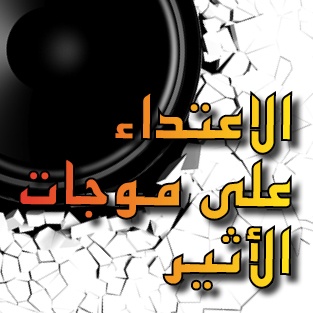 الاعتداء على موجات الأثير
الاعتداء على موجات الأثير
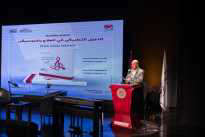 منشورات جامعة دار الكلمة تطلق أحدث إصداراتها الدليل التطبيقي في العلاج بالموسيقى للدكتور نورس كرزم
منشورات جامعة دار الكلمة تطلق أحدث إصداراتها الدليل التطبيقي في العلاج بالموسيقى للدكتور نورس كرزم
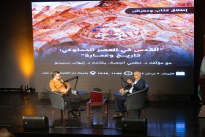 إطلاق كتاب "القدس في العصر المملوكي: تاريخ وعمارة" لمؤلّفه الدكتور نظمي الجعبة
إطلاق كتاب "القدس في العصر المملوكي: تاريخ وعمارة" لمؤلّفه الدكتور نظمي الجعبة
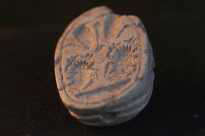 A little girl discovered a 3,800-years-old Canaanite seal
A little girl discovered a 3,800-years-old Canaanite seal